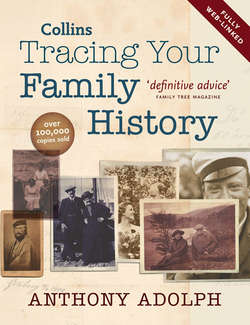Читать книгу Collins Tracing Your Family History - Ryan Tubridy, Anthony Adolph - Страница 82
WHERE TO SEARCH GENERAL REGISTRATION
ОглавлениеIf you know the exact name, date, place of the birth, marriage or death you want from 1900 onwards, you can place an order with the Registrar General without needing to look up the index reference. Usually, though, you will need to search for the event you want.
Until 1992, the only way to seek a birth, marriage or death was to visit St Catherine’s House (and earlier on, Somerset House) in London and search the heavy quarterly index volumes that weighed 25lb each. I used to spend a day a week doing it, and it was horribly hard, physical work, often with several eager searchers fighting over the same volume, or tripping over children and old ladies in the narrow aisles. In 1992, microfiche copies of the indexes were published, and these can still be found at TNA as well as in many archives, record offices and Mormon Family History Centres. They are far less physically demanding to search, but very hard on the eyes. For those without internet access, they now remain the only way of searching, because in October 2007 the index volumes themselves left their final public searchroom – the Family Records Centre at Myddleton Avenue, Islington, and were exiled to the Office of National Statistics’ offices (Somerford Road, Christchurch, Dorset, BH23 3QA) where they are not available for searching. The FRC remained open for a few months, finally closing in spring 2008.
In the early 2000s, copies of the General Registration indexes started appearing online, and are now available at a variety of sites: regardless of the site, remember that they are all copies of the same original indexes. The General Register Office had grand plans (codenamed ‘DoVE’) to make a full online index of all entries, showing additional information such as mothers’ maiden names for all births, spouses’ names for all marriages and ages for all deaths right back to 1837. At the time of writing plans have been completely shelved due to lack of funds, but check to see if this has now changed. Fingers crossed!
The best place to start looking is www.freebmd.org.uk. Volunteers are working on making a full index of births, marriages and deaths. It is not yet complete (the site includes graphs to show how complete each year is), and may never be. You will often find what is clearly the right entry, but never assume that you are looking at a complete index. If you are not absolutely sure you have found the right entry, you must now search in the complete indexes on microfiche or on other sites.
Next, the splendid site www.familyrelatives.com has full indexes for the births, marriages and deaths for the period 1866-1920, and 1983-2005. A search in these periods will return all the entries for the name you want, that are in the original indexes, the odd human indexing error aside. The site also has fully-indexed First and Second World War-forces deaths.
Many sites now offer access to the quarterly indexes from 1837 to the most recent available date. These include www.genesreunited.co.uk, www.ancestry.co.uk, www.thegenealogist.co.uk (which is actually the same as www.ukbmdindex.co.uk), www.findmypast.com (formerly www.1837online.com) – the latter has all the GRO indexes, including consular, army and ‘at sea’ indexes – as does www.familyrelatives.com. The latter has a great extra feature, whereby you can identify your connection to people named in index entries in such a way as other people who find the same entry can contact you.
Alternatively, for a fee, you can visit a superintendent registrar’s office to search the indexes for that district, or request a search by post, but only do this if you are convinced that the entries you want will all be in that registration district: if not, use the national indexes.
Many one-name societies (especially members of the Guild of One Name Studies, see here) and individuals interested in single surnames have produced exhaustive lists of General Registration references to that name. See General Register Office one-name lists in the library of the SoG, (SoG, 1997).
Certificates are often collected by local family history societies and archives, and others are published as ‘Unwanted Certificates’ in Family Tree Magazine, but the chances of these collections containing the very certificate you want are always going to be slim.
Several counties now have websites containing composite computerised indexes to local registrars’ indexes. For example, www.CheshireBMD.org.uk contains a growing proportion of the Cheshire registrars’ records for the period 1837 to 1950. Cambridge, Yorkshire, Lancashire, Middlesborough and Newcastle have begun similar indexing projects and other counties are likely to follow. An overview of these sites appears at www.ukbmd.org.uk. Certificates found through these sites can be purchased from the relevant registrar online for £7.00.
